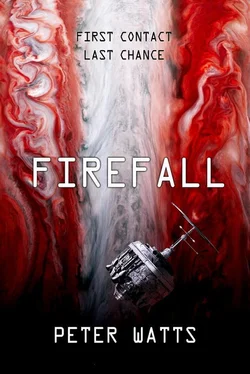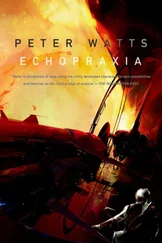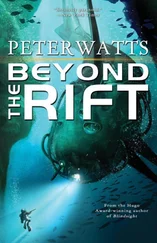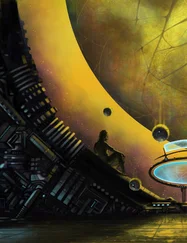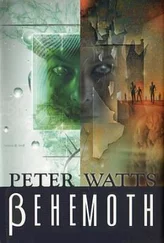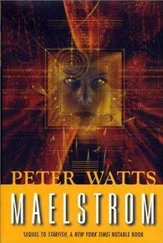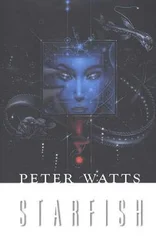In hindsight, it is apparent that describing the Bicamerals as a religious order is a little misleading: the parts of the brain they’ve souped up simply overlap with the parts that kick in during religious neurobehavioral events, so the manifestations are similar. Whether that’s a distinction that makes a difference is left as an exercise for the reader.
GOD AND THE DIGITAL UNIVERSE
The idea of God as a virus only really works if you buy into the burgeoning field of digital physics. [85] “Digital Physics,” Wikipedia, the Free Encyclopedia , September 17, 2013, http://en.wikipedia.org/w/index.php?title=Digital_physics&oldid=571364996 .
Most of you probably know what that is: a family of models based on the premise that the universe is discrete and mathematic at its base, and that every event therein can therefore be thought of as a kind of computation. Digital physics comes in several flavors: the universe is a simulation running in a computer somewhere; [86] Nick Bostrom, “Are We Living in a Computer Simulation?,” The Philosophical Quarterly 53, no. 211 (2003): 243–255, doi:10.1111/1467-9213.00309.
, [87] Nick Bostrom, “The Simulation Argument,” n.d., http://www.simulation-argument.com/ .
, [88] Brian Whitworth, The Physical World as a Virtual Reality , arXiv e-print, January 2, 2008, http://arxiv.org/abs/0801.0337 .
or the universe is a vast computer in its own right, where matter is hardware and physics is software and every flip of an electron is a calculation. In some versions matter itself is illusory, a literal instantiation of numbers. [89] Max Tegmark, The Mathematical Universe , arXiv e-print, April 5, 2007, http://arxiv.org/abs/0704.0646 .
, [90] Amanda Gefter, “Reality: Is Everything Made of Numbers?,” New Scientist 215, no. 2884 (September 29, 2012): 38–39, doi:10.1016/S02624079(12)62518-4.
In others, reality is a hologram and the universe is empty inside; [91] Zeeya Merali, “Theoretical Physics: The Origins of Space and Time,” Nature 500, no. 7464 (August 28, 2013): 516–519, doi:10.1038/500516a.
, [92] Marcus Chown, “Our World May Be a Giant Hologram,” New Scientist no. 2691 (2009): 24–27.
, [93] Dave Mosher, “World’s Most Precise Clocks Could Reveal Universe Is a Hologram,” Wired Science , October 28, 2010, http://www.wired.com/wiredscience/2010/10/holometer-universe-resolution/ .
the real action takes place way out on its two-dimensional boundary, and we are merely interferences patterns projected from the surface of a soap bubble into its interior. There’s no shortage of popular summaries of all this stuff, either online [94] “Rebooting the Cosmos: Is the Universe the Ultimate Computer? [Replay],” accessed September 10, 2013, http://www.scientificamerican.com/article.cfm?id=world-science-festival-rebooting-the-cosmos-is-the-universe-ultimate-computer-live-event .
or off. [95] B Greene, The Hidden Reality: Parallel Universes and the Deep Laws of the Cosmos (New York: Vintage Books, 2011).
Lee Smolin (of Waterloo’s Perimeter Institute) goes against the grain: he rejects digital physics outright and serves up a single universe in which time is not an illusion, reality is not deterministic, and universes themselves grow, reproduce, and evolve via natural selection writ very large (think of black holes as offspring; think of entropy as a selective force). [96] Lee Smolin, The Life of the Cosmos (New York: Oxford University Press, 1997).
, [97] Lee Smolin, “Time Reborn,” 2012, http://perimeterinstitute.ca/videos/time-reborn .
, [98] Lee Smolin, Time Reborn: From the Crisis in Physics to the Future of the Universe (Boston: Houghton Mifflin Harcourt, 2013).
Even Smolin’s model, however, is vulnerable to inconstancy in the laws of physics; the model actually predicts that physical laws evolve along with the rest of reality. Which kind of leaves us back at the question of how one can legitimately assume constancy in an inconstant universe.
You can’t get through these references without realizing that, whacked out as it sounds, digital physics has a lot of scientific heavy-hitters on its side. I, of course, am not one of them; but since so many smarter people are defending the premise, I’m happy to sneak viral deities onto the back of all their hard work and hope it slips through.
MISCELLANEOUS BACKGROUND AMBIANCE
The fieldwork preoccupying Brüks at the start of the story descends from the “DNA barcoding” that’s all the rage today: a quick-and-dirty taxonomic technique for distinguishing species based on a chunk of the cytochrome oxidase gene. [99] “DNA Barcoding,” Wikipedia, the Free Encyclopedia , September 17, 2013, http://en.wikipedia.org/w/index.php?title=DNA_barcoding&oldid=573251556 .
There’s no way it’ll still be around in its present form eight decades from now—we’ve already got handheld analyzers [100] Kevin Davies, “A QuantuMDx Leap for Handheld DNA Sequencing,” Bio-IT World , 2012, http://www.bio-itworld.com/2012/01/17/quantumdx-leap-handheld-dna-sequencing.html .
that put conventional wet analysis right out to pasture—but the concept of a genetic barcode will, I think, persist even as the technology improves.
The vortex engine [101] “Vortex Engine,” Wikipedia, the Free Encyclopedia , September 18, 2013, http://en.wikipedia.org/w/index.php?title=Vortex_engine&oldid=573492083 .
powering the Bicameral monastery derives from work patented by Louis Michaud, [102] Tyler Hamilton, “Taming Tornadoes to Power Cities,” The Toronto Star , July 21, 2007, http://www.thestar.com/business/2007/07/21/taming_tornadoes_to_power_cities.html .
a retired engineer who basically came up with the idea while tinkering in his garage. I have no idea whether two-hundred-megawatt, twenty-kilometer-high wind funnels are in our future, but the patents went through, [103] Kurt Kleiner, “Artificial Tornado Plan to Generate Electricity,” Technology: New Scientist Blogs , 2008, http://www.newscientist.com/blog/technology/2008/06/artificial-tornado-plan-to-generate.html .
and the project’s got some serious attention from government and academic agencies. Nobody’s saying the physics are wrong.
We are already closing in on learning techniques that bypass conscious awareness, [104] Kazuhisa Shibata et al., “Perceptual Learning Incepted by Decoded fMRI Neurofeedback without Stimulus Presentation,” Science 334, no. 6061 (December 9, 2011): 1413–1415, doi:10.1126/science.1212003.
à la Lianna Lutterodt’s training at the hands of her Bicameral masters. Likewise, the precursors of the gimp hood that Brüks uses in lieu of a brain implant can be seen taking shape in a diversity of mind-reading/writing tech already extant in the literature. [105] Jack L. Gallant et al., “Identifying Natural Images from Human Brain Activity,” Nature 452, no. 7185 (March 20, 2008): 352+.
, [106] T. Horikawa et al., “Neural Decoding of Visual Imagery During Sleep,” Science 340, no. 6132 (May 3, 2013): 639–642, doi:10.1126/science.1234330.
, [107] Kendrick N. Kay and Jack L. Gallant, “I Can See What You See,” Nature Neuroscience 12, no. 3 (March 2009): 245–245, doi:10.1038/nn0309-245.
, [108] Thomas Naselaris et al., “Bayesian Reconstruction of Natural Images from Human Brain Activity,” Neuron 63, no. 6 (September 24, 2009): 902–915, doi:10.1016/j.neuron.2009.09.006.
, [109] Jon Stokes, “Sony Patents a Brain Manipulation Technology,” Ars Technica , April 7, 2005, http://arstechnica.com/uncategorized/2005/04/4785-2/ .
Brüks’s dependence on Cognital, on the other hand, marks him truly as a relic of a past age (ours, in fact): memory boosters are already in the pipe, [110] Johannes Gräff and Li-Huei Tsai, “Cognitive Enhancement: A Molecular Memory Booster,” Nature 469, no. 7331 (January 27, 2011): 474–475, doi:10.1038/469474a.
, [111] Dillon Y. Chen et al., “A Critical Role for IGF-II in Memory Consolidation and Enhancement,” Nature 469, no. 7331 (January 27, 2011): 491–497, doi:10.1038/nature09667.
, [112] Reut Shema et al., “Enhancement of Consolidated Long-Term Memory by Overexpression of Protein Kinase Mζ in the Neocortex,” Science 331, no. 6021 (March 4, 2011): 1207–1210, doi:10.1126/science.1200215.
and as far back 2008, one in five working scientists already indulged in brain-doping to help keep up with the competition. [113] Brendan Maher, “Poll Results: Look Who’s Doping,” Nature News 452, no. 7188 (April 9, 2008): 674–675, doi:10.1038/452674a.
Читать дальше
